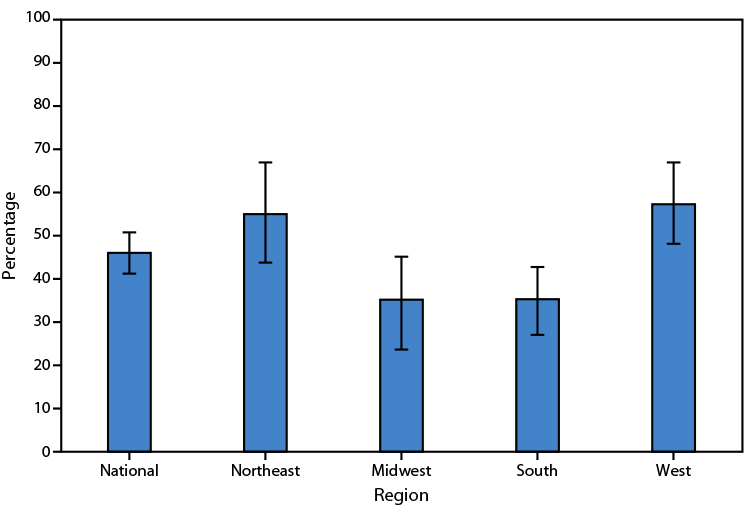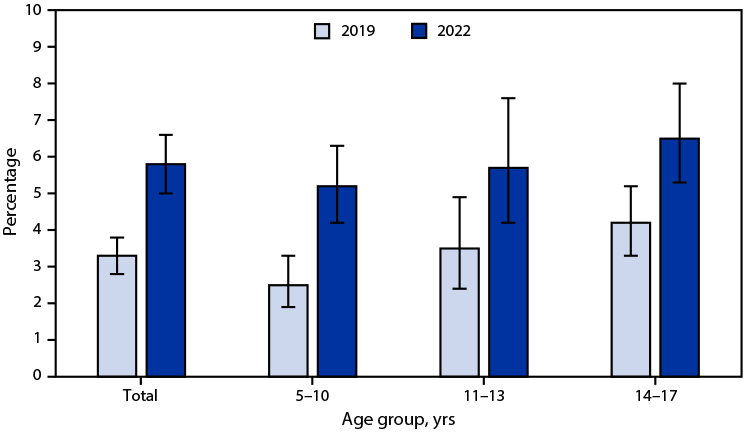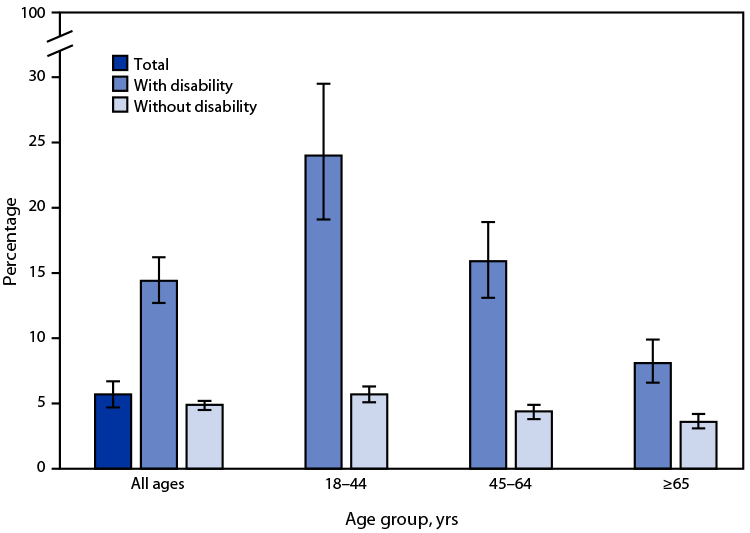NCHS: A Blog of the National Center for Health Statistics
QuickStats: Percentage of Children and Adolescents Aged ≤17 Years Who Used Telemedicine During the Past 12 Months, by Age Group and Year — United States, 2021–2023

The percentage of children and adolescents aged 0–17 years using telemedicine during the past 12 months declined from 18.3% in 2021 to 14.2% in 2023. Telemedicine use declined across all three age groups during this period. In both 2022 and 2023, telemedicine use increased with age. Supplementary Table: https://stacks.cdc.gov/view/cdc/159160 Source: National Center for Health Statistics, National Health Read More >
Posted on byQuickStats: Percentage of Adult Day Services Centers That Use Any Telehealth, by U.S. Census Bureau Region — United States, 2022

In 2022, 46% of U.S. adult day services centers used any telehealth tools. Approximately one half of centers in the Northeast and West used any telehealth, compared with approximately one third of centers in the Midwest and South. Supplementary Table: https://stacks.cdc.gov/view/cdc/157543 Source: National Center for Health Statistics, National Post-Acute and Long-Term Care Study, 2022. https://www.cdc.gov/nchs/npals https://www.cdc.gov/mmwr/volumes/73/wr/mm7330a4.htm Read More >
Posted on byNew Interactive Dashboard and Data File Feature Health Center Data
Two new developments provide more access to data on visits to health centers in the United States. The National Center for Health Statistics’s (NCHS) Division of Health Care Statistics recently launched an interactive dashboard and released a public use data file from the National Ambulatory Medical Care Survey (NAMCS). These resources feature data collected in Read More >
Posted on byDiscovering Teen Health Insights with the CDC’s NHIS-Teen Survey

With the release of the new report Perceived Social and Emotional Support Among Teenagers: United States, July 2021 – December 2022 from CDC’s National Center for Health Statistics, an important finding stands out: Parents often report that their teens receive higher levels of social and emotional support compared to what the teens report. The findings Read More >
Posted on byHear About NCHS Research at the 2024 Academy Health Annual Research Meeting
NCHS has several presentations and poster sessions at the 2024 Academy Health Annual Research Meeting from June 29 to July 2 at the Baltimore Convention Center. Highlights include: Sunday, June 30 8:00 a.m. – 9:15 a.m. (Halls A-B, Level 100) The session, The Experience of Physicians Who Use Telemedicine Technology: United States, 2021, will provide Read More >
Posted on byQuickStats: Percentage of Current Cigarette Smokers Aged ≥18 Years Who Received Advice from a Health Professional To Quit Smoking, by Sex and Age Group — United States, 2022

In 2022, 42.0% of current cigarette smokers aged ≥18 years received advice from a doctor, dentist, or other health professional about ways to quit smoking. The percentage of current smokers who received advice to quit smoking increased with age. Overall, and for current smokers aged 18–44 years, men were less likely to receive advice on Read More >
Posted on byU.S. Uninsured Rate Drops by 26% Since 2019

The overall number of Americans without health insurance dropped by 8.2 million from 2019 to 2023. These findings are included in a new report by the CDC’s National Center for Health Statistics (NCHS). The findings are featured in the report, “Health Insurance Coverage: Early Release of Estimates from the National Health Interview Survey, 2023.” It Read More >
Posted on byQuickStats: Percentage of Adults Aged ≥25 Years Who Met the 2018 Federal Physical Activity Guidelines for Both Muscle-Strengthening and Aerobic Physical Activity, by Educational Attainment — United States, 2022

In 2022, 22.5% of adults met federal guidelines for both muscle-strengthening and aerobic physical activity. The percentage of adults who met these guidelines increased with increasing educational attainment, from 12.2% among adults who completed high school or less to 33.6% among those with a bachelor’s degree or higher. Supplementary Table: https://stacks.cdc.gov/view/cdc/155046 Source: National Center for Health Statistics, Read More >
Posted on byQuickStats: Percentage Distribution of Deaths Involving Injuries from Recreational and Nonrecreational Use of Watercraft, by Month — United States, 2020–2022

During 2020–2022, a total of 1,481 deaths occurred involving injuries from recreational and nonrecreational use of watercraft. The highest percentage of these deaths (17.4%) occurred in July, with the majority occurring during May–September. Supplementary Table: https://stacks.cdc.gov/view/cdc/155045 Source: National Center for Health Statistics, National Vital Statistics System, Mortality Data, 2020–2022. https://www.cdc.gov/nchs/nvss/deaths.htm Read More >
Posted on byU.S. Overdose Deaths Decrease in 2023, First Time Since 2018

Provisional data from CDC’s National Center for Health Statistics indicate there were an estimated 107,543 drug overdose deaths in the United States during 2023—a decrease of 3% from the 111,029 deaths estimated in 2022. This is the first annual decrease in drug overdose deaths since 2018. The data are featured in an interactive web data visualization. Read More >
Posted on byExplore NCHS Research at the AAPOR Annual Conference
Researchers from the National Center for Health Statistics (NCHS) will present their work at the American Association for Public Opinion Research (AAPOR) 79th annual conference being convened May 15–17 at the Hilton Atlanta. The conference brings together researchers to focus on the theme of “Impacting Communities: Surveys, Public Opinion Research, and Engaged Scholarship” and to Read More >
Posted on byIntroducing the NCHS Data Query System

In today’s ever-changing public health landscape, access to comprehensive data is essential for informed decision-making. That’s why the Centers for Disease Control and Prevention’s National Center for Health Statistics (NCHS) has launched its newest tool: the Data Query System (DQS). DQS brings together data from major NCHS and external sources into one easy-to-use online tool. Read More >
Posted on byQuickStats: Percentage of Residential Care Communities That Use Electronic Health Records, by Community Bed Size — United States, 2018, 2020, and 2022

From 2018 to 2022, the percentage of residential care communities (RCCs) using electronic health records (EHRs) increased from 36% to 48%. Use of EHRs increased during this time regardless of RCC size, and larger RCCs were more likely to use EHRs compared with smaller RCCs. Supplementary Table: https://stacks.cdc.gov/view/cdc/153378 Source: National Center for Health Statistics, National Post-acute and Read More >
Posted on bySecond Round of Health Data Released by NCHS Rapid Surveys System

CDC’s National Center for Health Statistics has released the second round of survey data from the Rapid Surveys System. This survey includes topics such as: ADHD Chronic Pain Contraception Use Fit Testing of Hearing Protection Devices Illegal Drugs and Naloxone (Narcan) Awareness Online Connectedness Swimming Technology-facilitated Sexual Violence Topics included in Rapid Surveys will vary Read More >
Posted on byNew National Hospital Care Survey Public Use Files Released

The National Center for Health Statistics’s (NCHS’s) Division of Health Care Statistics has officially released the 2020 National Hospital Care Survey public use data files. These files include detailed data on inpatient stays and emergency department visits to hospitals across the United States. The release of these data files is one of several historic achievements Read More >
Posted on byU.S. Fertility Rate Drops to Another Historic Low

The general fertility rate in the United States decreased by 3% from 2022, reaching a historic low. This marks the second consecutive year of decline, following a brief 1% increase from 2020 to 2021. From 2014 to 2020, the rate consistently decreased by 2% annually. These statistics and others from provisional 2023 birth data were Read More >
Posted on byQuickStats: Percentage of Children and Adolescents Aged 3–17 Years Who Ever Received a Diagnosis of Autism Spectrum Disorder, by Family Income, 2020–2022

During 2020–2022, 3.4% of children and adolescents aged 3–17 years had received a diagnosis of autism spectrum disorder. The prevalence of autism spectrum disorder among children and adolescents decreased as family income increased. Supplementary Table: https://stacks.cdc.gov/view/cdc/152917 Source: National Center for Health Statistics, National Health Interview Survey, 2020–2022. https://www.cdc.gov/nchs/nhis.htm https://www.cdc.gov/mmwr/volumes/73/wr/mm7315a5.htm Read More >
Posted on byBeyond the Checkbox: New Standards for Health Data
Accurate data on race and ethnicity are essential for understanding the health of different populations. This information helps support public health programs and research. On March 28, 2024, the Office of Management and Budget (OMB) changed the way NCHS and other statistical agencies will be collecting data on race and ethnicity. OMB is responsible for Read More >
Posted on byQuickStats: Life Expectancy at Birth, by Sex — United States, 2019–2022
Life expectancy at birth for the U.S. population in 2022 was 77.5 years, an increase from 76.4 years in 2021. Although life expectancy rose in 2022 for the first time since the COVID-19 pandemic began, it remains lower compared with prepandemic life expectancy in 2019 (78.8 years). This pattern was similar for males and females. Read More >
Posted on byFrom Numbers to Knowledge: Building America’s Mortality Report
Today, the National Center for Health Statistics (NCHS) released final mortality data for 2022 and an accompanying data brief, “Mortality in the United States: 2022.” In 2022, 3,279,857 resident deaths were registered in the United States. When it comes to understanding the health of the nation, this annual data brief provides a key piece of Read More >
Posted on byMarriages in the U.S. in 2022 Returned to Pre-Pandemic Levels

In 2022, the United States witnessed a significant uptick in the number of marriages, reaching a total of 2,065,905[1]. This marked the first instance of surpassing the 2 million mark since 2019 when the figure stood at 2,015,603. The marriage rate also experienced a significant increase, reaching 6.2 per 1,000 population – the highest rate Read More >
Posted on byQ & A from the Report Author of Chronic School Absenteeism

Questions for Lindsey Black, Statistician and Lead Author of “Chronic School Absenteeism for Health-related Reasons Among Children Ages 5‒17 Years: United States, 2022” Q: What would you say was the most significant finding in this report? LB: There are few national data sources available to examine the prevalence of school absenteeism due to health-related reasons. Read More >
Posted on byQuickStats: Percentage of Children and Adolescents Aged 5–17 Years Who Had Chronic School Absenteeism Due to Illness, Injury, or Disability During the Past 12 Months, by Age Group and Year — National Health Interview Survey, United States, 2019 and 2022

The percentage of children and adolescents aged 5–17 years who had chronic school absenteeism during the past 12 months was higher in 2022 (5.8%) than in 2019 (3.3%). From 2019 to 2022, the percentage of children who had chronic school absenteeism increased for each age group. The percentage of children who had chronic school absenteeism Read More >
Posted on byQuickStats: Percentage of Adults Aged ≥18 Years Who Lacked Reliable Transportation for Daily Living in the Past 12 Months, by Disability Status and Age Group — National Health Interview Survey, United States, 2022

In 2022, 5.7% of adults aged ≥18 years lacked reliable transportation for daily living in the past 12 months. The percentage lacking reliable transportation for daily living among those with disability was higher (14.4%) compared with those without disability (4.9%). The percentages among persons with disability were higher than percentages among those without disability in Read More >
Posted on byThe National Center for Health Statistics Launches New Rapid Surveys System

Rapid and reliable response to public health needs has never been more crucial than in today’s world. The National Center for Health Statistics is now partnering with other CDC programs and government survey experts to fill information gaps by providing access to timely data through its new Rapid Surveys System. WHAT ARE RAPID SURVEYS? Rapid Read More >
Posted on by
